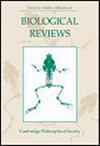动物代谢抑制:生理观点和生化概括。
摘要
几乎所有主要动物门在环境胁迫下都有代谢率下降的记录。抑郁程度通常用抑郁代谢率与正常静息代谢率之比来衡量。代谢率有时仅降至大约。静息值的80%(即大约。休息的20%);更常见的是静息期的5-40%(即大约。60-95%休息);极度抑郁是指休息时间减少到1%或更少,甚至达到无法测量的低代谢率(即大约为1%或更少)。99% -100%休息)。我们已经检查了动物的静止和抑制代谢率作为它们的体重的函数,校正到一个普通的温度。这种异速测量方法可以对不同动物的静息代谢率和抑制代谢率的绝对水平进行比较,并提出了三种代谢抑制的一般模式。首先,代谢抑制要接近。对于各种非隐生动物(如软体动物、蚯蚓、甲壳类动物、鱼类、两栖动物、爬行动物)来说,0.05-0.4的休息时间是一种常见且非常一致的模式。这种程度的代谢抑制是典型的具有“内在”抑制的休眠动物,即预期不利环境条件下代谢率降低,但其离子或渗透状态或体内水分状态没有实质性变化。这些类型的动物中的一些能够在缺氧中生存有限的时间,它们的无氧代谢抑制也大约是。0.05-0.4的静息。对于这些动物的一些“休眠”、“越冬”或失育的卵,代谢抑制明显低于静息的0.2,但这可能是由于早期发育停滞,因此卵的发育组织的“代谢质量”较低(与卵的总体质量相比),没有代谢抑制,而不是整个细胞质量的代谢抑制。冬眠(或冬眠)的哺乳动物和鸟类在冬眠期间的代谢率急剧下降,例如低于冬眠前的代谢率0.01,但除了由于体温调节控制的重新调整和伴随Q10效应的体温降低而导致的代谢率降低外,通常没有内在的代谢抑制。在浅休眠状态下,某些物种可能存在适度的内在代谢抑制(约为1。0.86),深度睡眠时代谢下降幅度更大(约0.86)。0.6),但与重新调整体温调节和Q10效应所产生的大量节约相比,这种内在抑制所产生的任何节能都是微不足道的。其次,隐生动物的代谢抑制模式更为极端(休息时间< 0.05)。对于这些动物来说,它们的内部环境发生了深刻的变化——对于无氧动物来说,它们缺乏氧气;对于渗透生物、无水生物或低温生物动物来说,它们体内水的离子/渗透平衡或状态发生了变化。一些正常需氧动物可以耐受缺氧相当长的时间,其耐受时间与代谢抑制的程度成反比;无氧代谢率可低于静息的0.005。无水动物的代谢率通常低到无法测量,如果不是零的话。因此,无水是卵或生命周期的其他阶段在长时间的环境压力下生存的最终策略。第三,在正常水合状态下(与无水或低温状态相反)缺乏代谢的模式显然是盐水虾(Artemia spp.,一种anostraman甲壳类动物)在缺氧状态下滞育的卵所特有的。缺氧但水合囊肿明显的完全代谢抑制(常氧、缺氧或渗透生物但水合囊肿的极端代谢抑制)是上述模式的明显例外。(ABSTDepression of metabolic rate has been recorded for virtually all major animal phyla in response to environmental stress. The extent of depression is usually measured as the ratio of the depressed metabolic rate to the normal resting metabolic rate. Metabolic rate is sometimes only depressed to approx. 80% of the resting value (i.e. a depression of approx. 20% of resting); it is more commonly 5-40% of resting (i.e. a depression of approx. 60-95% of resting); extreme depression is to 1% or less of resting, or even to an unmeasurably low metabolic rate (i.e. a depression of approx. 99-100% of resting). We have examined the resting and depressed metabolic rate of animals as a function of their body mass, corrected to a common temperature. This allometric approach allows ready comparison of the absolute level of both resting and depressed metabolic rate for various animals, and suggests three general patterns of metabolic depression. Firstly, metabolic depression to approx. 0.05-0.4 of rest is a common and remarkably consistent pattern for various non-cryptobiotic animals (e.g. molluscs, earthworms, crustaceans, fishes, amphibians, reptiles). This extent of metabolic depression is typical for dormant animals with 'intrinsic' depression, i.e. reduction of metabolic rate in anticipation of adverse environmental conditions but without substantial changes to their ionic or osmotic status, or state of body water. Some of these types of animal are able to survive anoxia for limited periods, and their anaerobic metabolic depression is also to approx. 0.05-0.4 of resting. Metabolic depression to much less than 0.2 of resting is apparent for some 'resting', 'over-wintering' or diapaused eggs of these animals, but this can be due to early developmental arrest so that the egg has a low 'metabolic mass' of developed tissue (compared to the overall mass of the egg) with no metabolic depression, rather than having metabolic depression of the entire cell mass. A profound decrease in metabolic rate occurs in hibernating (or aestivating) mammals and birds during torpor, e.g. to less than 0.01 of pre-torpor metabolic rate, but there is often no intrinsic metabolic depression in addition to that reduction in metabolic rate due to readjustment of thermoregulatory control and a decrease in body temperature with a concommitant Q10 effect. There may be a modest intrinsic metabolic depression for some species in shallow torpor (to approx. 0.86) and a more substantial metabolic depression for deep torpor (approx. 0.6), but any energy saving accruing from this intrinsic depression is small compared to the substantial savings accrued from the readjustment of thermoregulation and the Q10 effect. Secondly, a more extreme pattern of metabolic depression (to < 0.05 of rest) is evident for cryptobiotic animals. For these animals there is a profound change in their internal environment--for anoxybiotic animals there is an absence of oxygen and for osmobiotic, anhydrobiotic or cryobiotic animals there is an alteration of the ionic/osmotic balance or state of body water. Some normally aerobic animals can tolerate anoxia for considerable periods, and their duration of tolerance is inversely related to their magnitude of metabolic depression; anaerobic metabolic rate can be less than 0.005 of resting. The metabolic rate of anhydrobiotic animals is often so low as to be unmeasurable, if not zero. Thus, anhydrobiosis is the ultimate strategy for eggs or other stages of the life cycle to survive extended periods of environmental stress. Thirdly, a pattern of absence of metabolism when normally hydrated (as opposed to anhydrobiotic or cryobiotic) is apparently unique to diapaused eggs of the brine-shrimp (Artemia spp., an anostracan crustacean) during anoxia. The apparent complete metabolic depression of anoxic yet hydrated cysts (and extreme metabolic depression of normoxic, hypoxic, or osmobiotic, yet hydrated cysts), is an obvious exception to the above patterns. (ABST

 求助内容:
求助内容: 应助结果提醒方式:
应助结果提醒方式:


